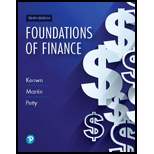
(Dividend policy and the issue of new shares of common stock) Cranfield Enterprises has just completed its annual planning and budgeting process and needs to raise $20 million to finance its capital expenditures for the coming year. The firm earned $18 million last year and will pay out half this amount in dividends. If the firm’s CFO wants to finance new investments using no more than 40 percent debt financing, how much common stock will the firm have to issue to raise the needed $20 million?
Want to see the full answer?
Check out a sample textbook solution
Chapter 13 Solutions
Foundations Of Finance
Additional Business Textbook Solutions
Financial Accounting (12th Edition) (What's New in Accounting)
Principles of Operations Management: Sustainability and Supply Chain Management (10th Edition)
Business Essentials (12th Edition) (What's New in Intro to Business)
Financial Accounting, Student Value Edition (5th Edition)
Horngren's Financial & Managerial Accounting, The Financial Chapters (Book & Access Card)
- Finance question 7. A person buys a stock for $100 and sells it for $120. What is the gain?A) $10B) $20C) $25D) $15arrow_forwardA person buys a stock for $100 and sells it for $120. What is the gain?A) $10B) $20C) $25D) $15arrow_forwardi need help!! If you invest $1,000 at 10% compound interest for 1 year, the amount is:A) $1,100B) $1,050C) $1,200D) $1,000arrow_forward
 EBK CONTEMPORARY FINANCIAL MANAGEMENTFinanceISBN:9781337514835Author:MOYERPublisher:CENGAGE LEARNING - CONSIGNMENT
EBK CONTEMPORARY FINANCIAL MANAGEMENTFinanceISBN:9781337514835Author:MOYERPublisher:CENGAGE LEARNING - CONSIGNMENT
